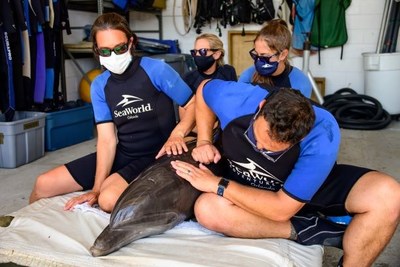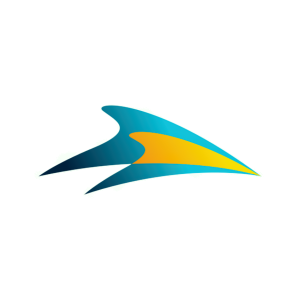SEAWORLD RESCUED AND REHABILITATED DOLPHIN AND SEA TURTLE DEEMED NON-RELEASABLE BY NOAA AND USFWS TRANSFERRED TO AN AQUARIUM IN CLEARWATER
SeaWorld Parks and Entertainment (NYSE: SEAS) announced the transfer of two rescued animals, a bottlenose dolphin named 'Apollo' and a green sea turtle named 'Boba Fett', to Clearwater Marine Aquarium. Both animals were deemed non-releasable due to chronic health issues identified by NOAA and USFWS. Apollo suffered from atypical hearing loss that hindered his echolocation abilities, while Boba Fett had suffered a spinal injury. This move reflects SeaWorld’s commitment to animal welfare, having rescued over 39,000 animals historically.
- Transfer of rescued animals to suitable permanent care reflects commitment to animal welfare.
- Successful rehabilitation of Apollo and Boba Fett demonstrates SeaWorld's expertise in animal care.
- Apollo's atypical hearing loss prevents him from survival in the wild, indicating serious health concerns.
- Boba Fett's spinal injury and chronic buoyancy issues highlight the challenges faced by rescued animals.
Insights
Analyzing...
ORLANDO, Fla., Dec. 14, 2021 /PRNewswire/ -- SeaWorld Parks and Entertainment (NYSE: SEAS) today announced that two SeaWorld rescued and rehabilitated animals deemed non-releasable by The National Oceanic and Atmospheric Administration (NOAA) and U.S. Fish and Wildlife Service (USFWS), two government authorities, were transferred to the Clearwater Marine Aquarium today. The pair includes the bottlenose dolphin 'Apollo' and the green sea turtle 'Boba Fett' (an endangered species). NOAA (dolphin) and USFWS (turtle) determined these animals were unable to return to the wild post rehabilitation due to chronic health conditions.
"While our goal is to return
Dr. James "Buddy" Powell, Executive Director at the Clearwater Marine Aquarium, said: "It is because of the wonderful team work, respect, and professionalism executed by each organization that these two now have a second chance at life. I want to thank the teams at Hubbs-SeaWorld Research Institute, Florida Fish and Wildlife Conservation Commission, and NOAA for coordinating and executing Apollo's rescue and for the team at SeaWorld Orlando for providing both animals with excellent care during their rehabilitation."
"SeaWorld is a trusted partner in the rescue and rehabilitation of marine mammals and we're so grateful for the excellent care they've provided to Apollo over the past 6 months. We're sure he will continue to thrive at his new home," said Dr. Erin Fougères, NOAA Fisheries Marine Mammal Stranding Program Administrator.
Stranded This Year, Dolphin 'Apollo' Begins a Journey of Recovery
On May 15, 2021, the Hubbs SeaWorld Research Institute (HSRI) received a call of a dolphin stranded on the Canaveral National Seashore off the East coast of Florida. Given his condition, in consultation with NOAA Fisheries, a decision was made to transport the dolphin for rehabilitation at SeaWorld Orlando.
SeaWorld veterinarian and dolphin specialist Dr. Lydia Staggs was the first to examine Apollo upon arrival. "We determined him to be at or under the age of two and given his young age we needed to move quickly to do a thorough health assessment and get him back into water as fast as possible," she said. "We performed our standard blood workup immediately and spaced out the radiographs and endoscopy (to ensure he had not ingested any foreign objects) over a few days to keep his time out of the water limited. Everything looked good."
However, he was approximately 15 percent underweight and needed to gain 30 pounds to reach a healthy body weight for his age. He also had a fairly common parasite issue for which he underwent treatment. With these issues under control, a hearing test was conducted as part of the standard pre-release protocol. The test administered by the National Marine Mammal Foundation (NMMF) confirmed a diagnosis of atypical hearing loss for his age that compromised his ability to echolocate. Echolocation is the method dolphins use to find food in the wild.
Research indicates that more than half of stranded bottlenose dolphins have severe hearing loss. The study also shows that hearing impairment could play a significant role in causing cetaceans (whales, dolphins, porpoises) to strand.
Dr. Staggs added, "This condition meant that survival on his own was unlikely because lack of echolocation is not a condition they can overcome – it's how they hunt and survive. The good news is that animals with this condition do great in human care and his future looks very bright."
Due to his hearing loss, NOAA Fisheries determined Apollo was not a candidate for release and selected CMA as his permanent home. He joins PJ and Hemingway as the third dolphin at CMA rescued and rehabilitated by SeaWorld.
The Little Endangered Green Turtle Rescued in 2018 Starts his Long-Anticipated Next Chapter
On May 4, 2018 a seven-pound green sea turtle in distress was brought to SeaWorld for rehabilitation. Approximately 2-4 years in age, he was found in Volusia Florida floating in water and unable to dive. His outer shell was severely fractured, a traumatic injury likely resulting from a boat strike. The green sea turtle is a common species in Florida and one of the most frequent patients of the SeaWorld Critical Care facility in Orlando. Although they are found off the coasts of 140 countries, they are considered either threatened or endangered (depending on its population) under the Endangered Species Act.
Affectionally named 'Boba Fett' after a small but mighty Star Wars character, the little green turtle came under the care of experienced SeaWorld veterinarian Dr. Stacy DiRocco. "He came to us with a deep wound across the top of his shell that ran down the center of his back and we suspected given its severity that it had impacted his spine," she said.
While his wound began to heal, he continued to display positive buoyancy – a condition where the animal is unable to dive below the water line – and he was unable to use his flippers well. Multiple x-rays and a CT scan confirmed a spinal injury. Unfortunately, survival rates for turtles with these conditions are zero without long term human care.
Dr. DiRocco added, "We adore this little guy - he is a survivor, cute as a button, and has a great personality. We knew he needed a special forever home, and we are so grateful he has found a place with other green sea turtles at CMA. We know CMA will take great care of him and his special needs."
While at SeaWorld, 'Boba Fett' tripled in size – now nearly 20 pounds. Green sea turtles can grow up to four feet long and reach 400 pounds and have an average life expectancy of 30-40 years.
SeaWorld commonly provides permanent homes for non-releasable animals, however not all of those rescued and rehabilitated join its resident population. SeaWorld is part of a large global community of zoos and aquariums all committed to helping animals and providing long term care for those in need.
SeaWorld is accredited by the Association of Zoos and Aquariums (AZA) and Alliance of Marine Mammal Parks & Aquariums and certified by American Humane. Follow us on Facebook, Instagram, SeaWorld Cares for more information.
About SeaWorld Parks & Entertainment
SeaWorld Entertainment, Inc. (NYSE: SEAS) is a leading theme park and entertainment company providing experiences that matter, and inspiring guests to protect animals and the wild wonders of our world. The Company is one of the world's foremost zoological organizations and a global leader in animal welfare, training, husbandry, and veterinary care. The Company collectively cares for what it believes is one of the largest zoological collections in the world and has helped lead advances in the care of animals. The Company also rescues and rehabilitates marine and terrestrial animals that are ill, injured, orphaned, or abandoned, with the goal of returning them to the wild. The SeaWorld® rescue team has helped more than 39,000 animals in need over the Company's history. SeaWorld Entertainment, Inc. owns or licenses a portfolio of recognized brands including SeaWorld®, Busch Gardens®, Aquatica®, Sesame Place® and Sea Rescue®. Over its more than 60-year history, the Company has built a diversified portfolio of 12 destination and regional theme parks that are grouped in key markets across the United States, many of which showcase its one-of-a-kind zoological collection. The Company's theme parks feature a diverse array of rides, shows and other attractions with broad demographic appeal which deliver memorable experiences and a strong value proposition for its guests.
Media Contact:
Mediarelations@seaworld.com
![]() View original content to download multimedia:https://www.prnewswire.com/news-releases/seaworld-rescued-and-rehabilitated-dolphin-and-sea-turtle-deemed-non-releasable-by-noaa-and-usfws-transferred-to-an-aquarium-in-clearwater-301444214.html
View original content to download multimedia:https://www.prnewswire.com/news-releases/seaworld-rescued-and-rehabilitated-dolphin-and-sea-turtle-deemed-non-releasable-by-noaa-and-usfws-transferred-to-an-aquarium-in-clearwater-301444214.html
SOURCE SeaWorld Parks & Entertainment









